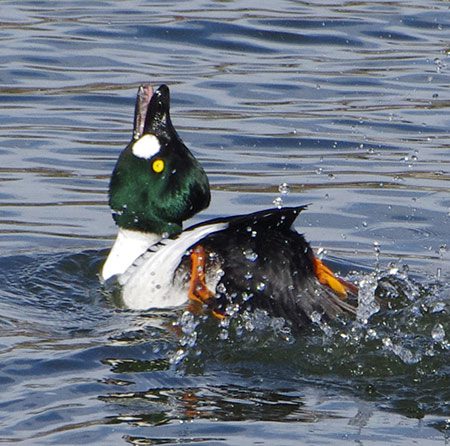How to Recognize Duck Courtship Displays
By Jessie Barry January 20, 2015As winter’s chill sets in, ducks are heating things up. Winter is the season when many ducks pick their mate for the year. Our featured video gives you a mash-up of some of the best duck mating behaviors from the Cornell Lab’s Macaulay Library. Watch for these behaviors on neighborhood ponds, lakes, and rivers that don’t freeze over.
Most species of ducks find a different mate each year. Many waterfowl pair bonds form between the months of December and March on the wintering grounds or during spring migration, which is different from songbirds that find their mate after they arrive on their breeding grounds spring.
In waterfowl mating, it’s the female’s choice. Groups of males perform for the female, and she picks her favorite drake with the best plumage and the best display. Some waterfowl species have some incredible courtship moves, such as the Head-Throw-Kick performed by Common Goldeneye and the Salute-Curtsy signature move of a Red-breasted Merganser. These are ritualized behaviors— members of the same species perform the same display that is hard-wired into their genetic makeup. Courtship displays range from elaborate postures to subtle gestures that you may notice only if you are watching for them.
Commonly Seen Mallard Courtship Behaviors
To see duck courtship in action, find a group of Mallards and take a minute to watch what they are doing. Most of the time they’ll probably be feeding or resting, but if they’re actively swimming around, watch for these behaviors.

Head-Pumping: Males and females rhythmically bob their heads. This display is often repeated and followed by mating.

Head-Up-Tail-Up: With a loud whistle, the drake pulls his wings and tail up, shows off his purple-blue secondaries and compresses his body. This is a quick gesture, often given by males in a group to impress the female.

Grunt-Whistle: A one-second display where the male raises out of the water, pulls his head up, and gives a remarkable whistle, followed by a grunt as he moves back into a normal posture. Often given by groups of males to show off for females.

Nod-Swimming: A male or female swims rapidly for a short distance with its neck held low, just grazing the surface of the water. Females use it to express they are interested in courtship and stimulate the nearby males to display. Males perform this display during bouts of Head-Up-Tail-Up display and immediately after mating.

Looking for Ducks This Winter? Over the course of the winter waterfowl shift south as frigid lakes of Canada and the northern U.S. freeze over. National Wildlife Refuges, coastal bays, reservoirs, and warm-water outflows can have incredible duck concentrations! Check out eBird under the ‘Explore Data’ tab for recent sightings near you.
Find out more about ducks and bird courtship:
- Simple Steps for Identifying Confusing Brown Ducks—Females and Otherwise
- Courtship on the Tundra—Spoon-billed Sandpipers [Field Report]
- Read all about duck courtship behaviors and more in Birds of the World.
- Check out the Lab’s online course Courtship & Rivalry in Birds

All About Birds
is a free resource
Available for everyone,
funded by donors like you
American Kestrel by Blair Dudeck / Macaulay Library
